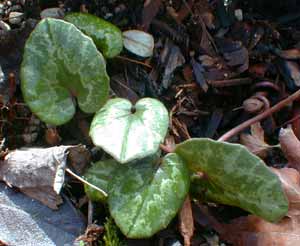
Cilician
Cyclamen
"Beneath the branches of the olive yard
Are roots where cyclamen & violet grow.
Beneath the roots the earth is deep & hard,
And there a king was buried long ago."
-from "An Etruscan Burial" by
Mary Agnes Robinson
1857-1930
Mary Agnes Robinson
1857-1930
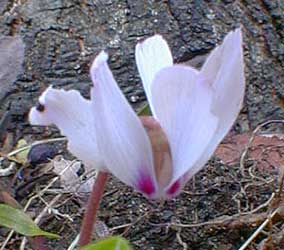 A local nursery had stocked in a few Cyclamen cilicium in full autumn flower, & after the blooms were worn out, most people stopped buying them. So the nursery put what remained on sale, & we got three inexpensive pots to plant at the foot of a pin oak at mid-winter.
A local nursery had stocked in a few Cyclamen cilicium in full autumn flower, & after the blooms were worn out, most people stopped buying them. So the nursery put what remained on sale, & we got three inexpensive pots to plant at the foot of a pin oak at mid-winter.A year later a similar sale occurred of mostly C. coum, among which stocks were just two C. ciliciums. So I got all the C. coum to use at a landscaping job, but grabbed the two C. ciliciums to add to the small array I'd planted a year before.
Their location under the pin oak gets good morning sun year round, but especially in winter when the cyclamens are in maximum leafiness but the deciduous shrubs & trees in the vicinity have no leaves, permitting diffuse overhead light. While spring perennials are not present, cyclamens spice up this area considerably.
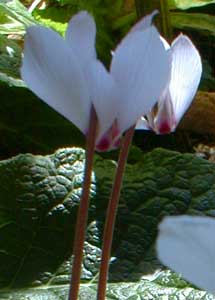 The first photo shows only the leaves in February (2004). Mostly the leaves are cordate with more or less smooth edges, but one of ours has very distinctly scalloped leaves, as shown in the fourth photo below from October (2005).
The first photo shows only the leaves in February (2004). Mostly the leaves are cordate with more or less smooth edges, but one of ours has very distinctly scalloped leaves, as shown in the fourth photo below from October (2005).The leaves die back before mid-spring, then the following August the very first flowers appeared, as shown in the second photo. Leaves begin to reappear in September, & there will be flowers & leaves until December. The third & fourth photos are from August 2005. The number of flowers, appearing ahead of the leaves, increased through September, as leaves very, very slowly began to appear.
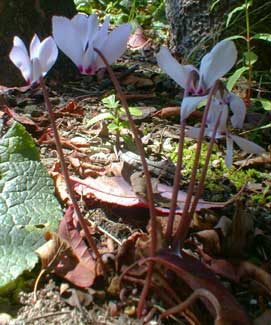 Though it is true that C. hederifolium & C. coum are even hardier, C. cilicium is likewise very easy to grow. It can stand temperatures down to zero degrees Fahrenheight. Our winters even during surprising cold-snaps are never so cold as that.
Though it is true that C. hederifolium & C. coum are even hardier, C. cilicium is likewise very easy to grow. It can stand temperatures down to zero degrees Fahrenheight. Our winters even during surprising cold-snaps are never so cold as that.Cilician cyclamens leaf out mid to late September & begin blooming right away. They flower from August through November, then the leaves persist until March. The blooms are a faded rose-pink with a dark plum-pink "nose" on the bottom center of the petals. Blooms possess an extremely faint odor of honey.
They are usually beginning to flower shortly after C. hederifolium & well before C. coum, so that between these three species, Autumn & Winter cyclamen blossoms will be uninterupted from late summer to early spring.
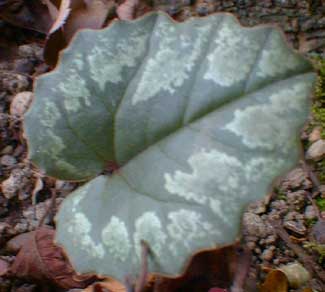 Cilician Cyclamen can stand a bit more sun than other hardy cyclamens, best liking moderately dry bright shade. In its natural environment of the Taurus Mountains of southern Anatolia, it would grow under conifers in soil acidified by needle-fall, & it is sometimes recommended to give them a light mulching of fir or pine needles. Planting it amidst the roots of shrubs or trees helps keep the tubor from getting too wet, as roots of shrubs help keep the soil around the tubers from too much dampness. In a more open situation this cyclamen would prefer raised beds that drain rapidly.
Cilician Cyclamen can stand a bit more sun than other hardy cyclamens, best liking moderately dry bright shade. In its natural environment of the Taurus Mountains of southern Anatolia, it would grow under conifers in soil acidified by needle-fall, & it is sometimes recommended to give them a light mulching of fir or pine needles. Planting it amidst the roots of shrubs or trees helps keep the tubor from getting too wet, as roots of shrubs help keep the soil around the tubers from too much dampness. In a more open situation this cyclamen would prefer raised beds that drain rapidly.Oval to heart-shaped leaves have cloudy mottling surrounding an ivy-leaf pattern. The leaves are smaller than C. coum but larger than C. intaminatum. Although the leaf color & pattern of the Cilician Cyclamen do not have the amazing range of variation as does C. coum, some specimens do have a more sharply outlined ivy-leaf or fir-tree-silhouette dominating the center of each leaf, while others are more subtle.
It has less variation than C. coum because it has a more limited range, found mainly in southern Turkey, spilling into Armenia. This area was in ancient times known as Cilicia.
The harsh western half of Cilicia where the Cilician Cyclamens proliferate was for millenia very little populated, except by goat-herding tribal peoples whose fierce independence kept them from ever being as fully conquered by Persians & Syrians as was true for the often-conquered eastern half of ancient Cilicia. These peoples built shrines for the warlike supernal huntress Artemis Taurica. Coastal Cilicians were notorious & ferocious pirates, yet when the herding Cilicians got hold of shipwrecked sailors, they turned them over to priestesses of Artemis who bled them to death on mountain altars.
The Cilician Cyclamen was sacred to this Tauric Artemis, having special significance because flowering in winter, evidence that the world was fertile & alive even in seemingly deathly winter.
Continue to
Cyclamen cilicium forma alba,
White Cilician Cyclamen